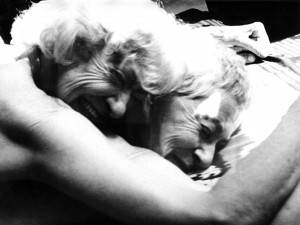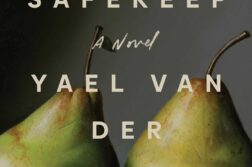LESBIAN FILMMAKER and video artist Barbara Hammer, now in her early seventies, has been exploding long-held myths about both gender and the art of filmmaking since the 1970’s. Her portrayals of lesbian sex, menstruation, female orgasm, and the full range of human sexuality have propelled her into the forefront of radical lesbian filmmaking and cinema itself.

Hammer has made over eighty films and videos that have been shown at Sundance, Toronto, Frameline, and Berlin, among other international film festivals. Her awards include the Leo Award for outstanding contributions to film, the Shirley Clarke Avant-Garde Filmmaker Award, and the Women in Film Award. She has appeared in no fewer than three Whitney Biennials and has had retrospectives at the Centre Pompidou, the Digital University in Taiwan, and Universidad Complutense in Madrid. Now coinciding with the recent publication of Hammer! Making Movies Out of Sex and Life (Feminist Press at CUNY, 2010), retrospectives of her work will be held at the Museum of Modern Art in New York, the Bozar Centre for Fine Arts in Brussels, and the Tate Modern in London.
CL: Your new memoir takes us back to your early decisions as a filmmaker. Why did you feel compelled to project a lesbian sensibility into your films?
BH: I came out with a woman and was discovering my lesbian sexuality in California in the 1970’s. I discovered that film included everything: painting and sculpture, environment and installation, music and architecture. It could be whatever I wanted it to be, and I could have complete control. My worldview had changed from being a heterosexual to being a homosexual. It was very much a sexual change more than a cultural change at that time. A woman touching my body reinforced my sense of touch. The lovemaking with a lesbian woman was an all-over body approach. That encouraged my sense of touch. The opposable thumb and the clitoris have more nerve endings than any other place in our body, especially the clitoris. Dyketactics, a formative film, has 110 images with a sense of touch in it. You see a foot going through a hot tub, touching another woman’s leg, a woman caressing her own breast, oral lovemaking. I call it a lesbian commercial sometimes because it’s packed with so many images. Sync Touch (1981-2) is about connecting perception in sight and touch. For me the screen is a sensual place; it’s tactile.
CL: Like the skin?
BH: Yes, like the skin, it’s a haptic sensibility. When I look at the world, I understand it through sensation. That means for me kinesthetic physical sensation that I feel in my body what I see with my eyes. Often people will tell me, “I’ve never been so in touch with my body until I saw your films”.
CL: In developing that sensibility, you spoke of certain sensations. How would you describe the emotional component of those?
BH: Emotion is key. I think emotions are triggered by touch. I tried to put emotion into structural film. Structural filmmaking looks at the system of signs that make up filmmaking. For example, focusing on the frame line or sprocket holes, or on the zoom of the lens. By understanding the phenomena of signs that make up a film you can deconstruct cinema to its basic elements.
The only woman in the Structuralist film movement was Joyce Wieland. Her work influenced me, but I think my first big film using structural tenets but adding emotional content was Optic Nerve (1985). I push my grandmother through the door of a nursing home five or six times. Each time I reprinted the shot of a reflection of me pushing her through the door, I reduced the emotional trauma of the act.
CL: Your emotional threshold?
BH: Yes. Every time I re-photographed the emotional scene it got dimmer and dimmer, fuzzier and fuzzier. We distance ourselves through replaying that same event over and over again in our minds or on film. I also had another theme in Optic Nerve and that theme was to show that I’m making film; I’m not trying to make an illusion, so I show the sprocket holes, frame lines. The most important element was to break the 3-D illusion of cinema and to show that the screen is flat. I was able to do that by using an optical printer, which is a re-photography device. It was very important to enter film history where the avant-garde was—which was Structural cinema—but to insert my own æsthetics by bringing back emotional content to film.
CL: Is that related to narrative art, some kind of a story line?
BH: Yes, if you want a theme—it begins from grandma outside the nursing home in a wheelchair going into her room, in her bed, and me reaching for her and her pulling away. It takes place in sixteen minutes. It’s rather Proustian, or a kind of simultaneous time in space that Gertrude Stein talks about that interests me. Everything can be contained within a moment.
CL: That’s the Möbius strip you talk about in your book, where it comes back on itself in a continuous narrative—beginning, middle, and no end; rather a constant replay.
BH: Yes, if we use our minds and we’re aware and we’re not just blanking out, we follow the implications of the scattered details of our lives. It occurs most naturally when we are not overcome by ordinary life details. In that space we can experience multiple places in our memory and then replay them. You can’t really hold them in your mind at the same moment—Morocco, Southern France, South America, South Africa, all the places I’ve visited, say. I can do it, but only sequentially, not simultaneously. It’s a kind of reservoir to draw upon at will.
CL: What was the state of lesbian cinema when you started out?
BH: I decided to be a filmmaker after I took a film history class and we saw everything from Georges Méliès to Jean-Luc Godard. Finally, one day, there was a different film on the screen and I felt a woman’s sensibility. It was Maya Deren’s Meshes of the Afternoon (1943). When I saw that film I knew this was a different kind of sensibility in cinema and that there was a blank screen for lesbians. There was no lesbian cinema: the screen was totally blank. I knew I could make films to fill that hole.
CL: How does being a lesbian feminist artist differ from say just being a lesbian artist? I bring it up because of the accusation of lesbian feminists being “essentialists” during that whole period of the 70’s and into the 1980’s.
BH: It’s a difficult question. Essentialism was an absolutist criticism and a real attempt to silence a lot of us. Luckily, it didn’t stop me. But I was hurt by it—all of us were hurt by the sweeping authoritarianism of the criticism. It did lead me to question my own work and develop further through that reflection. It led me to more politically relevant work. I made Snow Job: The Media Hysteria of AIDS (1986) and continued to make cultural critiques in my essay documentaries of the 90’s. Just because I project a body on the screen and that body is nude and she’s standing between some trees in nature does not mean that I’m saying that she is biologically determined.
CL: You mean because we as women are sexualized to such a great extent?
BH: If you claim to be a feminist, that’s a feminist act. If you claim to be a lesbian filmmaker, right there you’re establishing lesbian culture. If you don’t say it, history will be empty and you are going to be placed in the same struggle I was in trying to look for a foremother. You do not have a culture unless you have a ground to stand on. Take a film like History Lessons (2000), where I’m looking for lesbian history before Stonewall and all I’m finding are films made by men that have sexualized, medicalized, and legalized lesbians. To turn those films on their asses and camp them up is a groundwork for a lesbian culture and is a lesbian critique.
CL: How has your recent battle with cancer impacted your work, especially where the body is involved?
BH: Well, I was diagnosed with ovarian cancer stage III-C in February 2006. So this July it will be 4 ½ years in remission. At first I thought, “I’m not going to make another film. There’s too much else to do. I just want to look at life and experience mine. I don’t want to be in my studio working with a computer.” However, after finishing chemo I realized that no one was dealing with ovarian cancer, so I made the film A Horse Is Not A Metaphor (2008) to confront this silence. Besides the film, I worked on my archive. I got all my films in shape, my paper archives sorted, and I started looking for places to put them.
CL: Finally, let’s talk about aging in the gay community. Women seem to be increasingly invisible.
BH: Hidden. Did you ever read Barbara Cooper on the invisibility of age? She talks about going to the hardware store to buy a hammer, and she’d be ignored because she had gray hair. We weren’t hiding as lesbians when we came out. There were pejorative statements and anti-gay laws back then. Now we have to be the gray lesbian–feminist Panthers. We have to recognize each other on the street, make eye contact, flirt, smile at each other, and support each other. We deserve to be respected by a younger generation. We have to expect that. We have to refuse to disappear. We may not have the energy we once did, but that doesn’t mean you stay home. Keep going to the Garden Party, keep going to the CUNY events, and don’t move aside when you’re walking down the sidewalk because a guy has targeted you as a pushover for the space. This guy is going to have to bump my shoulder, acknowledge that I’m there in my space, and get used to it. My point is, we are leaving documents and ground to stand on for a younger generation, so when people get discouraged they can look to us for encouragement, go on fighting as we have and still are. That’s the legacy.






